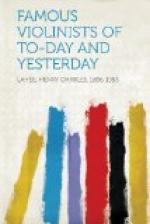It was in 1873 that Ysaye, after preparation given chiefly by his father, made his way to Brussels and sought out Wieniawski, then professor at the Conservatoire. Wieniawski was teaching, when a note was brought to him marked “private and important.” The servant was told to show the bearer in, and Ysaye, then about fifteen years of age, timidly entered the room carrying his violin. After a little preliminary conversation which allowed the youth to tell his history, Wieniawski asked him what he would play, and in reply he placed on the piano desk a concerto of Vieuxtemps. The result of his performance was that he at once became a pupil of Wieniawski, with whom he remained some three years, during the period in which Vieuxtemps was recovering from his paralytic shock. In 1876 Vieuxtemps heard him at Antwerp, and through his influence the Belgian government was induced to grant Ysaye a stipend in order to allow him to pursue his studies at Paris. There he was the pupil of Massart, who had also been the teacher of Wieniawski, Ysaye’s master at Brussels. Vieuxtemps is said to have expressed the desire, while in Algiers during his latter years, to have Ysaye stay with him to play his compositions, but Ysaye was at that time in St. Petersburg. When Vieuxtemps died and his remains were brought to Verviers, his birthplace, Ysaye carried in the procession the violin and bow of the virtuoso on a black velvet cushion fringed with silver.
When Ysaye first appeared in America he was a mature artist, the recognised leader of the Belgian school of violinists, the first professor of violin at the Brussels Conservatoire, and the possessor of many decorations and honours bestowed upon him by various royalties.
Before he had been in America a month he was acknowledged to be the greatest violinist who had visited this country for many years.
A man of large and powerful physique, he plays with a bold and manly vigour, and yet with exquisite delicacy. He is a master of phrasing and of all beauties of detail, has a wonderfully perfect technique, but that quality which places him at the head of all rivals is his musical feeling, his temperament. He has been compared to Rubinstein and to Paderewski. He inspires his hearers, or, as it was once expressed, very neatly, “he creeps up under your vest.” He disarms criticism, and he seems to be more completely part of his violin and his violin of him than has been the case with any other player who has visited these shores for some years. He has given the greatest performance of the celebrated Bach chaconne ever heard in America. He has been declared to be not inferior to Joachim in his performance of this work, though he has not so broad a tone as the latter, nor as Wieniawski. He combines Sarasate’s tenderness of tone and showy technique with more manliness and sincerity than Sarasate gives.
The student, perhaps, can learn more from Cesar Thomson than from Ysaye, but he will receive from the latter the greater inspiration.




